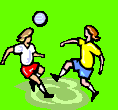Ball Run Fun For Preschoolers
Kick Ball
Curriculum Area: Physical Development
Self: Physical motor movement/cognitive.
Ages of Children and Group Size: 4-6 size and 4-7 age
Objective:
a. What are my goals on this identified activity?
-- Engage in simple physical activities for a short to moderate period of time, while following simple directions of the activity. As well as Engage in frequent bursts of active play that involves the heart, the lungs, and the vascular system. And to teach them why one ball goes further than the other by letting them figure it out by open ended questions
b. Preschool Learning Foundations (PLF)
-- 1.0 Active Participation: will be taking turns with each other to kick the ball as hard as they can and guess which will go further.
-- 2.0 Cardiovascular Endurance: Will be running and ball kicking.
Materials:
a. What materials are needed?
- Decent size bounce balls about the size of a soccer ball
- A second ball that’s a bit larger
- Poster board to mark down which one goes the farthest
b. How will I set up and organize the materials for maximum efficiency and effectiveness?
-- I’ll have a line of kids and a ball ready for them to kick once they kick it they will run to it and bring the ball back to me then kick the second ball and do the same.
Procedure:
a. How will I introduce this activity to the children? (Connect to children’s prior learning or experience)
-- Ask them if they ever kicked a ball or know any games that involves kicking a ball, then ask how far does it go when you kick it.
b. How will I involve the children?
-- The child will then kick the ball as far as they can to see how far they can make it go then get the ball and bring it back. Then they will kick the second ball and do the same. After this I’ll ask them which one went further and why. Then mark on the poster board what one went further.
c. What open-ended questions to ask to increase learning?
-- What will happen if we kicked the ball?
-- Why did the ball move when you kicked it?
-- What can we do to make it go farther?
-- Which ball went further?
-- Why did it go further?
d. How will you accommodate the activity for diverse learners…..delays, typical, extension and ELL?
-- I’ll do examples for them and help each one of them if needed and give them the time they need to understand it.
Evaluation:
a. How will you document or assess that the children learned the identified concepts?
Identify DRDP objectives that correspond to the PLF.
-- Measure 38 Gross motor movement/ uses complex movement skills in active play
-- Measure 27 Cause and effect/ try’s out action and sees what happen/ Shows understanding of familiar cause and effects through language or action
Take Home Kit:
a. Related Book:
b. Weblink activities:
-- http://www.pecentral.org/lessonideas/ViewLesson.asp?ID=2262#.U3pVWfRDuSo
-- http://www.toddler-activities-at-home.com/preschool-scienceactivities_movement.html


Parent Letter
Today’s lesson plan will teach your child about ball sizes and why a larger ball or smaller ball will go father then the other. They will hypothesize which one will go further in this activity. This activity will promote physical development and cause and effect, as to what happens when we kick the ball. They will kick the ball as hard as they can to see how far it goes, then run to it and bring it back. After they bring back the first ball they will kick a larger ball and do the same. Then be questioned why one went further than the other. Once they Answer and figure out why one went further than the other they will tally it on a chart I made for the day.
If any more questions come to mind about this activity please let me know before or after class I would be glad to help thank you
-Michael Perez
